How to Fill Raised Garden Beds with Organic Soil
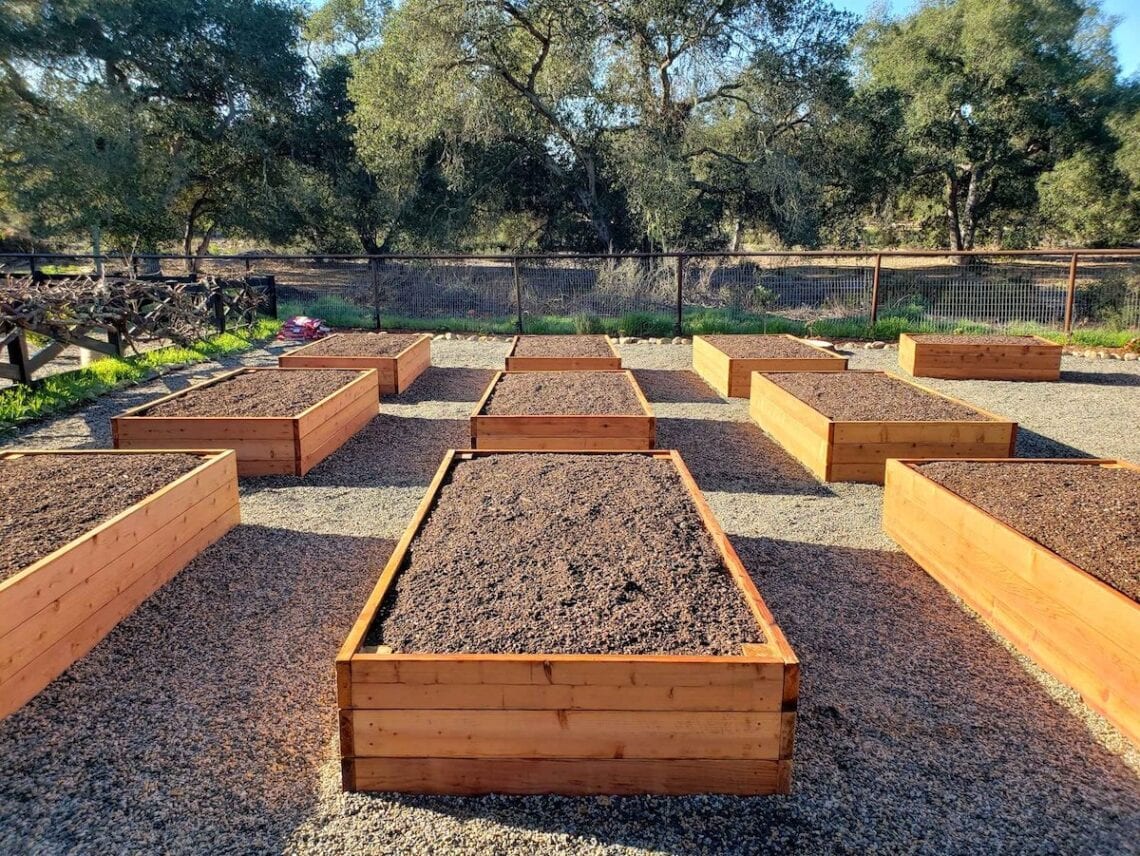
Do you have new planter boxes that need filling? Read along and learn how to fill raised garden beds with quality organic soil that is well-balanced, nutrient-rich, and microbially-active to help your plants thrive. After all, soil health is KEY to the overall health and productivity of your garden! It’s something you want to “get right” from the start.
In this article I will share our raised bed soil recipe – with options for using bagged or bulk soil, compost, and our favorite organic fertilizers or other amendments. Learn how to calculate bed volume and soil needs, the importance of mulch, and explore the hugelkultur method to fill raised garden beds. Last but not least, I’ve included tips on how to improve existing soil if your garden beds are already full but underperforming.
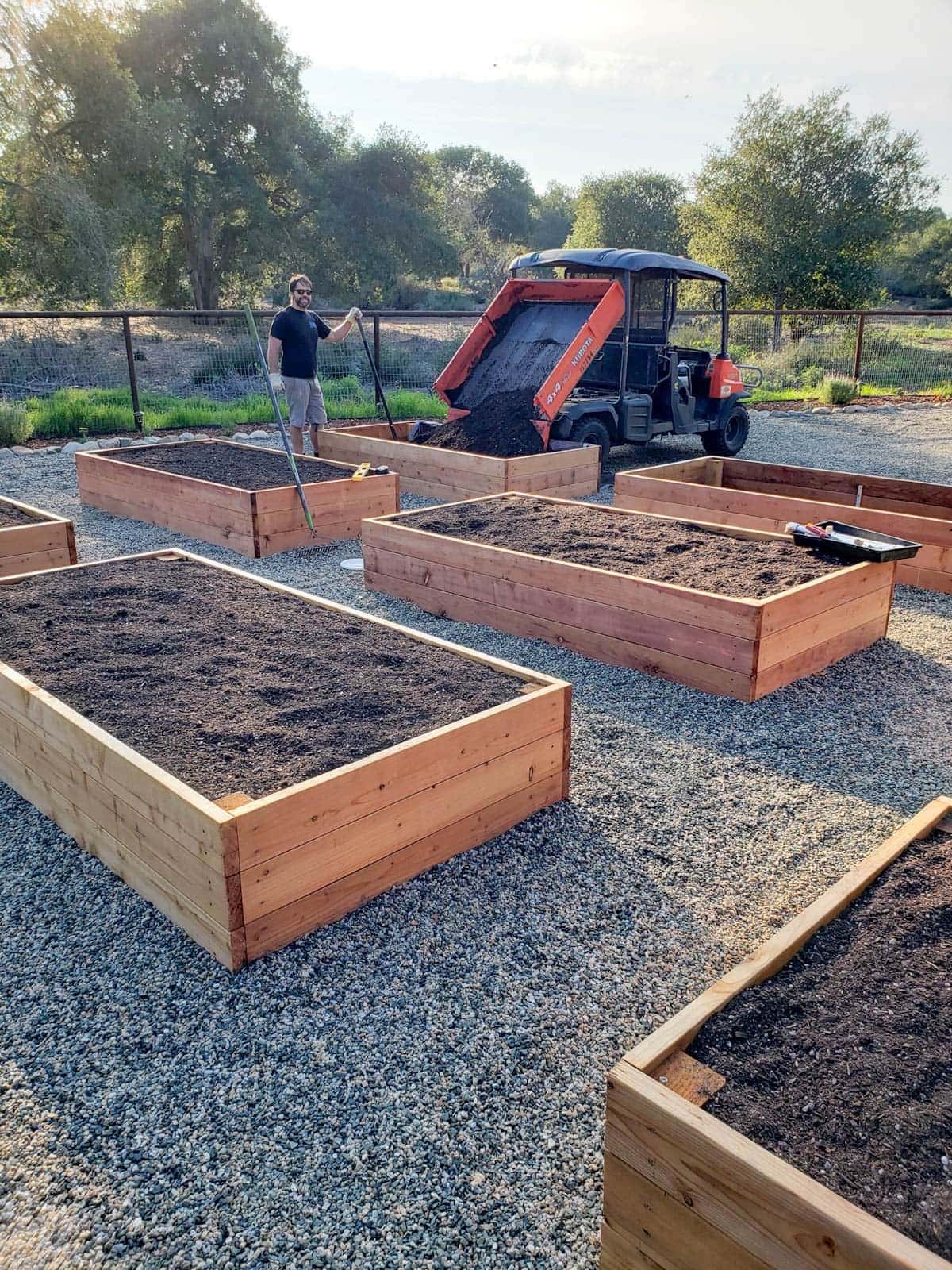
Would you like to save this?
Disclosure: Homestead and Chill is reader-supported. When you purchase through links on our site, we may earn an affiliate commission.
Getting Started with Raised Beds
Don’t miss our guide on how to build a durable DIY raised garden bed! The tutorial includes a step-by-step video and explores wood choices, bed sizing, location and layout best practices, tips for gopher-proofing beds, non-toxic sealer, and other ways to make wood raised beds last longer.
Don’t want to build your own? Check out the high-quality, long-lasting, galvanized metal Birdies raised beds from Epic Gardening – code “deannacat3” will save 5%! We love our Birdies too.
Once you have your beds in place, it’s time to fill ’em up.

Investing in quality raised bed soil
Let’s set the record straight: “Dirt” is not soil! Soil is rich, full of nutrients, critters, microorganisms, and is biologically active! In contrast, dirt is usually devoid of all these things. Soil improves with time and age, as the soil food web blossoms. It is a living, breathing, dynamic ecosystem of its own.
No matter how much love, energy, or money you invest into your garden, if you have crummy soil, the result will be crummy plants. If you’ve gone through the effort to build or buy yourself some awesome raised garden beds, why skimp on the soil? However, the answer isn’t as simple as “go grab X brand of soil”. In my experience, not one soil is going to be perfect for growing vegetables on its own – bulk or bagged.
If you’re blessed with decent native soil, you can use some of that to fill your raised beds to offset cost (explored below).

The Best Soil for Raised Beds
Confined to a large container, raised bed soil needs are unique and slightly different than in-ground gardens. The goal is to fill raised beds with soil that’s fertile, rich in organic matter, holds moisture, but also has good drainage and plenty of air pockets using a combination of quality organic soil (bagged and/or bulk), compost, and an aeration additive.
Our raised bed soil recipe
- 40% soil (topsoil, loam, native soil, etc)
- 40% well-aged compost
- 20% aeration (e.g. sand, lava fines, perlite, pumice, coco coir, peat moss, and/or rice hulls)
- Other amendments such as worm castings and gentle, slow-release organic fertilizers
We’ll talk about each of these components in more detail below. Note that the ratios are approximate; they don’t need to be exact. Also note that the ratios will change if you primarily use bagged soil, which usually already includes compost and aeration (perlite) – such as 80% bagged potting soil and 20% compost.
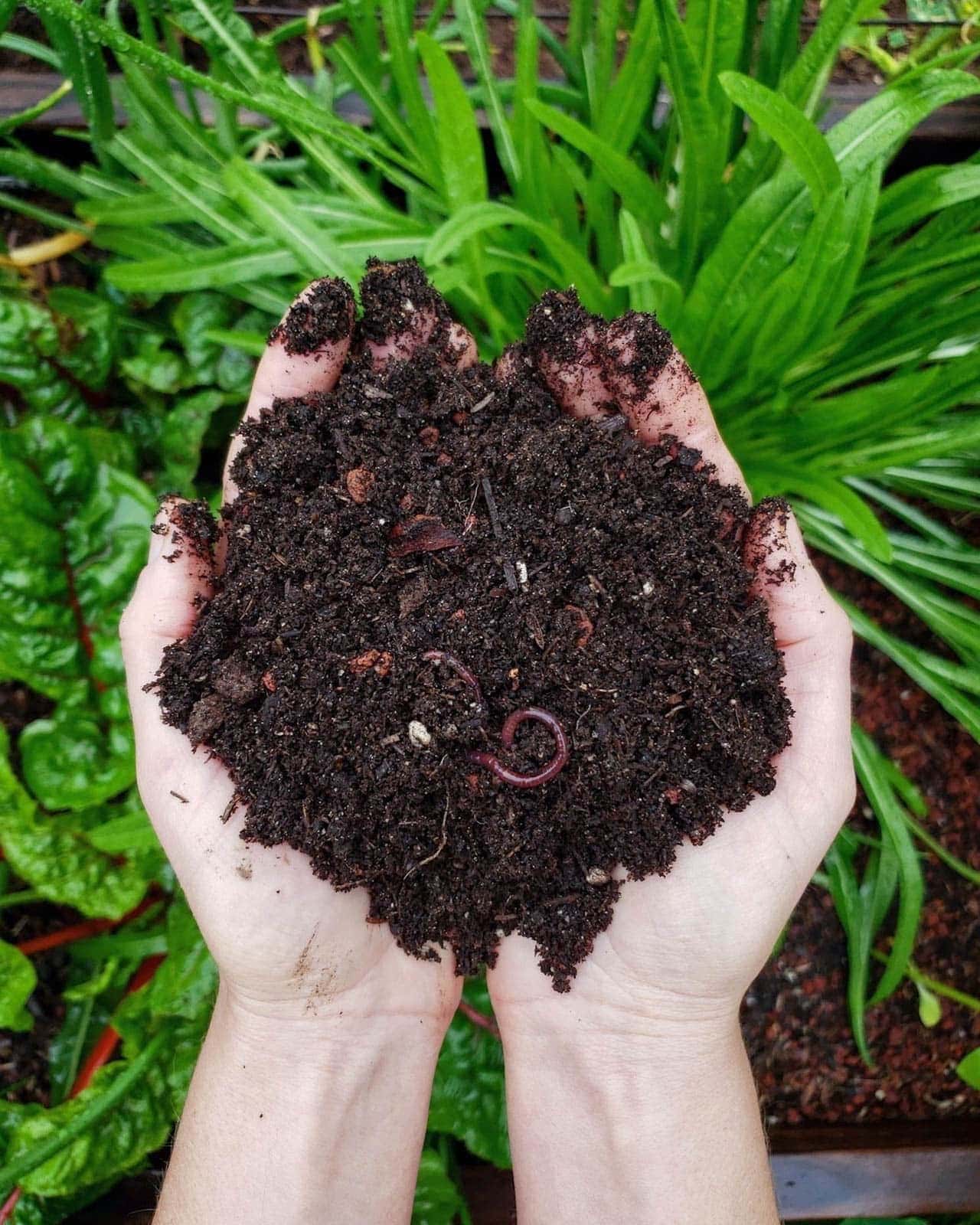
Calculating Soil Volume
Before soil shopping, you’ll need first to calculate the internal volume of your bed(s). Bags of soil come in measurements of cubic feet, usually in a range of 1 to 3 cubic-foot bags. Bulk soil purchased from a local landscape supply company will be in cubic yards.
To calculate how much soil you need to fill a raised garden bed, begin by determining the volume of your bed in cubic feet. To do this, simply multiply the width by length by depth in feet (For example: 4’ x 8’ x 1.5′ = 48 cubic feet).
Now you have your total cubic feet, and can figure out how much bagged soil it would take to fill the bed. If you’re using bulk soil or compost too, you’ll need to calculate volume in cubic yards. To convert to cubic yards, simply multiply cubic feet by 0.037037 (or use this converter). Given the example of a 4×8′ by 1.5-foot deep bed used above, 48 x 0.037037 = 1.7 cubic yards of soil is needed to fill it.
If math isn’t your strong suit (or you’re just feeling lazy…. no shame!) here is a raised bed soil calculator that will do it all for you, in both cubic feet or yards.

40% SOIL
Using Bulk vs Bagged Soil (or compost)
If you calculated that you need several yards of soil to fill your raised garden beds, you are not going to want to rely on bagged soil alone. The cost will add up quick! Look up local landscape supply companies and see what they offer in bulk – either for delivery or for pick-up, if you have a truck.
On the other hand, if you need to fill only one or two modest raised beds, purchasing bagged soil could be the way to go.
We often get bulk soil and compost delivered from Central Coast Landscaping or Mier Brothers here on the California Central Coast.
Bulk Soil Options
Bulk soil quality, composition and type will vary depending on your location. In our area, we’ve found varying grades of bulk soil including basic topsoil or “fill”, some premium container blends (similar to bagged soil), and a middle-of-the-road “planters mix” that is 2 parts top soil, 1 part compost and 1 part soil conditioner.
The composition of bulk soil will influence how much/what else to mix with it. For instance, if you all you can find is basic fill or topsoil, then you’ll want to follow the full raised bed soil recipe of 40% topsoil, 40% compost and 20% aeration to create a nice well-balanced soil. Or, use mediocre bulk soil as a “filler” at the bottom of deep raised beds, with a better soil on top.
Yet if you’re able to find premium raised bed soil in bulk, then it likely already contains a good amount of compost and aeration (sand, perlite, etc) so you can therefore scale back on those component of the recipe respectively. The landscape supplier should be able to provide details of the ingredients and make-up of the soils they offer!
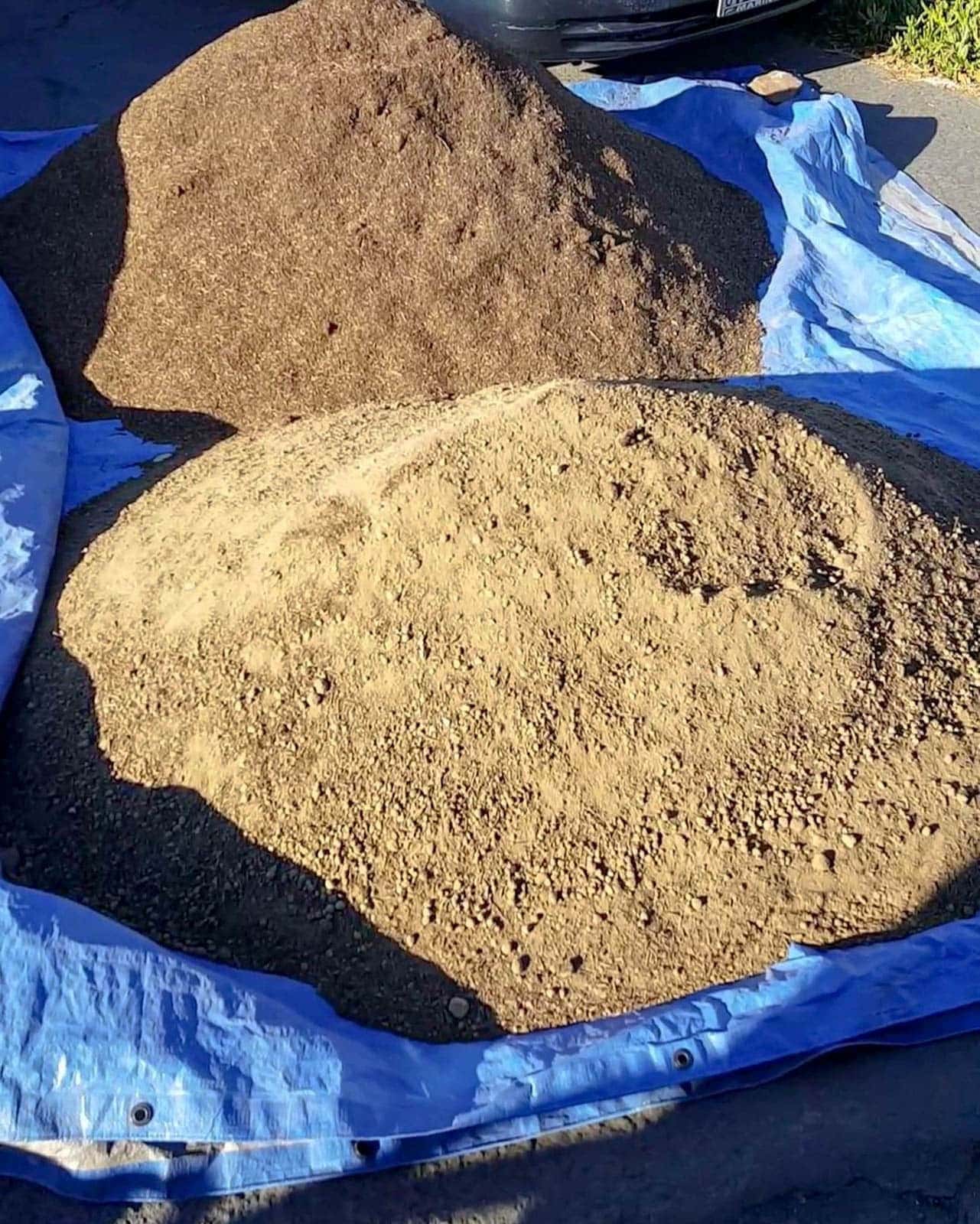
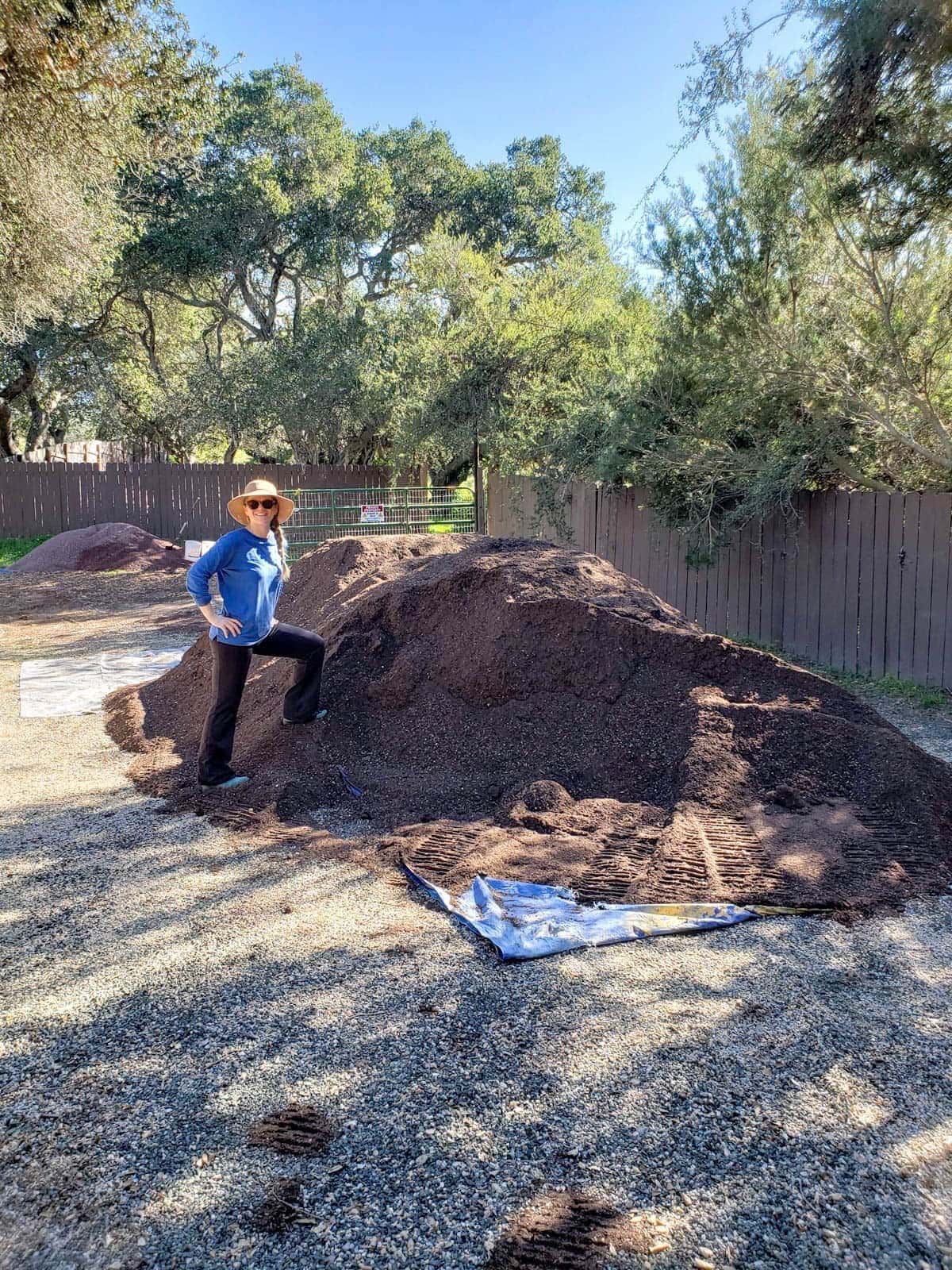
Bagged Soil Options
Even if we use good bulk soil to fill the majority of our raised beds, we always add at least a few bags of high-quality organic bagged soil near the top. We’ve used a wide variety of bagged soils over the years, but tend to prefer the selections offered at our local garden centers and nurseries over big box stores. “Hydro” grow shops (those geared towards hemp growers) usually have a great selection of premium soils too.
A few good options include E.B. Stone, Aurora/Roots Organics, Gardener & Bloom (G&B), Dr. Earth’s, and Fox Farms. Other cheaper or generic bagged soil can be used as filler towards the bottom of the bed, especially if you’re filling raised beds with bagged soil alone.
If possible, choose a few different types of bagged soil. Do not use “potting soil” only. It is light, fluffy, and will dry out quickly. In the photo below, you can see that we mix various types of bagged soil and conditioners. By combining a few different things, you’re getting a nice variety of composition and texture. Some are a little more woody, some more fluffy, some with perlite or pumice, some with or without added fertilizers.
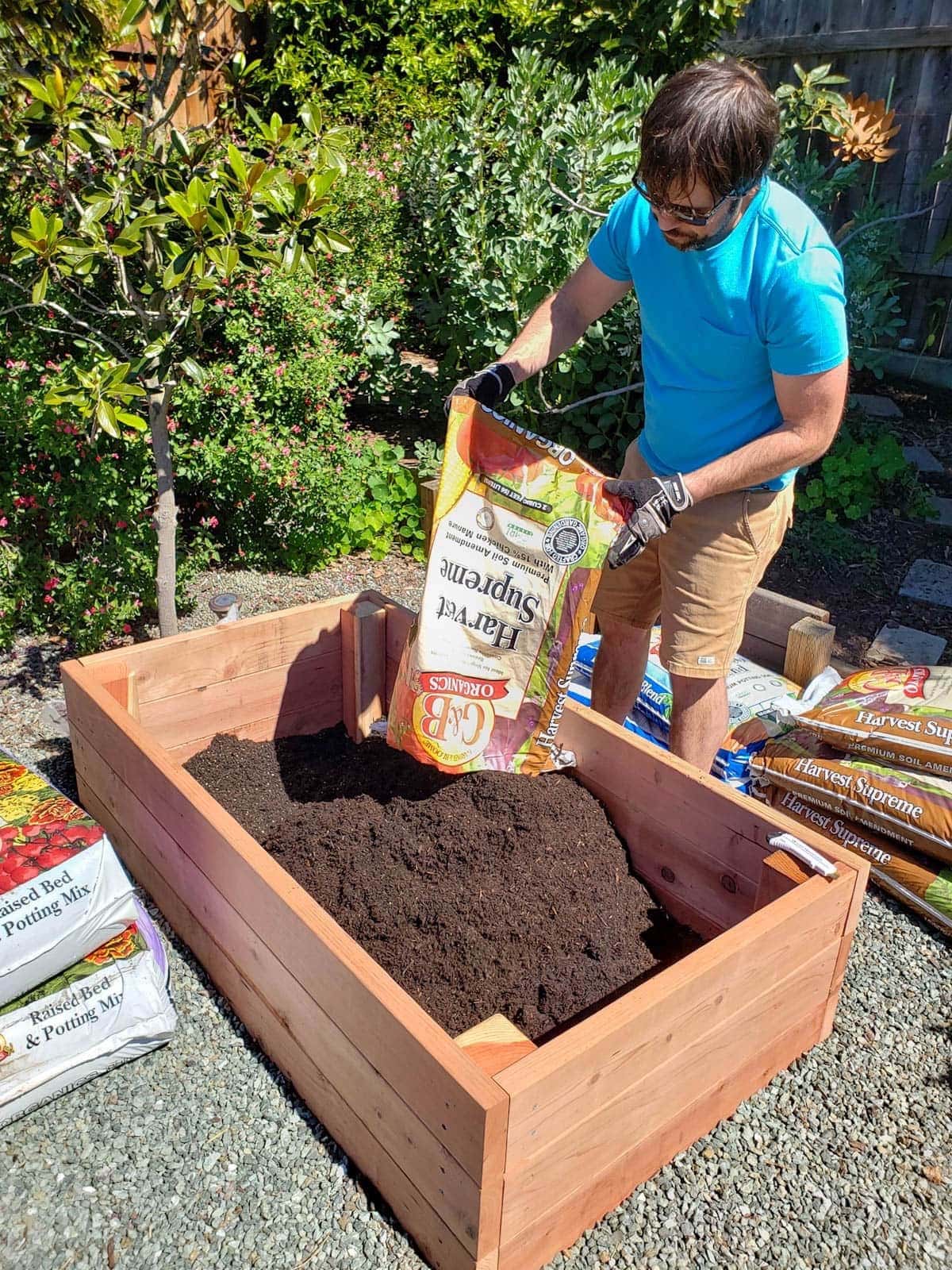
40% COMPOST
Compost is organic matter that has been thoroughly broken down and decomposed into rich nutrient-dense plant food. It is a phenomenal soil conditioner, boosts the soil food web, and will make your garden shine!
We add plenty of homemade compost from our worm bin, larger compost piles, and aged/composted manure from our mini donkeys, but usually cannot make quite enough to meet all of our needs – especially for large projects like filling new raised garden beds with soil. So we do end up supplementing with organic bagged compost or bulk compost too.
Keep in mind that most bagged soils usually already have compost in them. So unless you’re using plain topsoil in your raised bed soil recipe, feel free to scale the “compost” ratio down to 10-30% (depending on the soil you’re using).
RELATED: See this guide to learn 6 ways to compost at home or this tutorial to learn how to build a DIY compost bin!

Compost Options
Many popular soil companies offer bagged compost products too. Again, these can be found at your local garden center or hydroponics grow shops. You should also be able to find compost locally in bulk, which is usually derived from green waste or possibly composted food waste. The bulk compost we purchase is made from local green waste and is OMRI-certified for organic gardening.
Our favorite bagged compost is Malibu Compost Biodynamic Blend. It is made from aged, composted cow manure from certified-organic, biodynamic dairy farms. However, please note that Bu’s compost is quite rich, so they recommend mixing only 25% of their compost to your soil blend.
Unfortunately, Bu’s is primarily available on the West Coast. If you live in the Northeast, Coast of Maine makes a similar product. I’m sure there are many more companies out there, all over the U.S. Leave a comment if you are aware of a good local product like this in your area!

Worm Castings
Last but certainly not least, worm castings (aka worm poop!) are compost too. Worm castings are so good for your plants, they’re referred to as “black gold”. Worm castings offer gentle, slow-release fertilizer as well as improve soil structure, microbe activity, water retention, and drainage.
I highly recommend keeping a worm bin at home! It is a terrific way to divert food waste from the landfill, and up-cycle that “waste” into an incredibly valuable product for your garden or house plants. Worm bins are inexpensive and easy to maintain. Learn how to make a DIY worm bin here!
If you aren’t up for keeping your own worm bin, you could purchase finished worm castings and add at least a small mount to each bed. We can usually find bags of G&B Organics Worm Gro locally, or you could pick up some worm castings online here or from Uncle Jim’s Worm Farm.

20% AERATION
An aeration addition is also key to healthy, effective soil. This could include lava rock, pumice, or perlite. Coarse sand also promotes aeration and drainage, but not quite as effectively as the others.
A lot of bagged soil mixes already contain aeration additives, which also includes things like peat moss or rice hulls. So if you use primarily bagged soil, read the ingredient list and adjust accordingly. You can likely go lighter on additional aeration (e.g. perhaps only 5-10% extra, if any).
Benefits of Soil Aeration
All the beneficial organisms found in soil need air to survive, including microbes, nematodes, worms, protozoa, fungi, and more. Even more, plant roots need air to thrive too! Plants breathe through their roots just as much as they do through leaves. That’s why it’s important to not overwater, and always provide drainage holes in pots. Otherwise, plants will drown!
An aeration additive also helps the soil achieve a ideal moisture balance. They create air pockets, promote good drainage, and prevent the soil from over-compacting. At the same time, they also increase moisture retention by absorbing water like a sponge, which helps the soil stay evenly moist for a longer period of time between watering.
Our Choice: Lava Rock
For the aeration portion of our raised bed soil recipe, we have come to love volcanic rock. It is also called “lava cinders” and is frequently used in aquaponics. Use the small 3/8 inch to quarter-inch size, not larger chunks! Lava rock is full of pores, that not only promote aeration and drainage, but are also the perfect habitat for beneficial microbes to grow. They don’t float to the soil surface like white bits of perlite do, and are generally more affordable than pumice.
Our local landscape supply company carries volcanic rock both in bulk and in half cubic-foot bags. If you can’t find volcanic rock, use small perlite or pumice. Availability of all these products will vary depending on your location.

How to Fill a Raised Garden Bed
Now that you have our raised bed soil recipe, it is time to fill them up!
We prefer to fill our garden beds 100% full of soil and compost. Aside from sometimes adding lesser-quality bulk soil to the bottom of our deepest beds, there’s no other “fillers” at the bottom. See notes about fertilizer additions or using hugelkultur (adding leaves or sticks to the bottom of beds) in the sections to follow.
As you fill the beds, try to mix all of the various ingredients as evenly as possible. We’ll generally add them in “lasagna layers”, mixing as we go. For example, add several inches of bulk soil or bagged soil, a good layer of compost, a couple inches of volcanic rock, and mix. With that, the bed may only be about quarter full. Repeat with more layers of each, mix. Continue this process until the bed is full.
Also, it’s best to fill garden beds with soil all the way to the top – giving the roots as much depth to grow in as possible. When you first water a new bed it will compact and sink down a little too. Depending on how much it sinks, you may want to top it off with another layer of compost or soil.
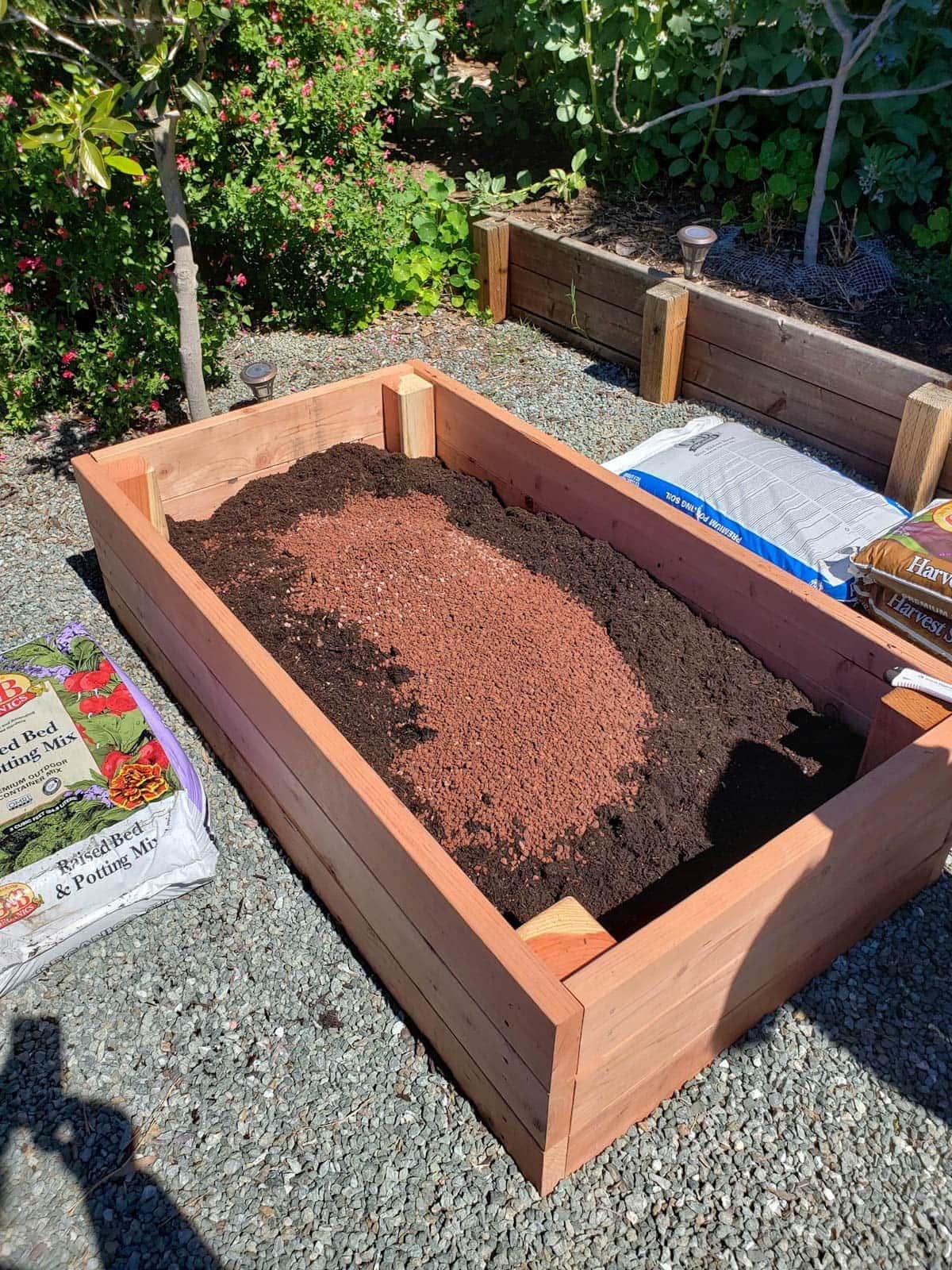
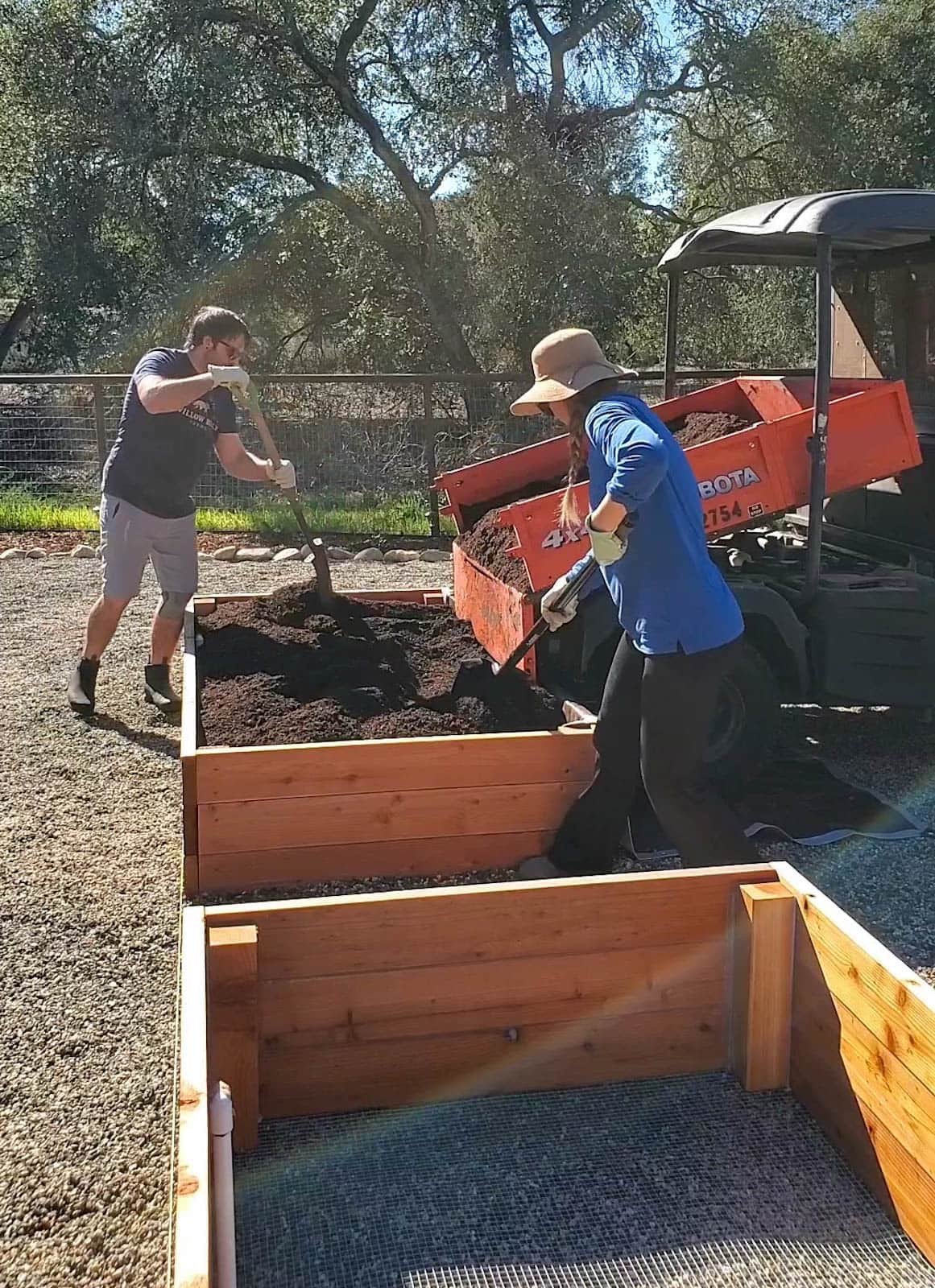
What About Hugelkultur?
When filling a deep raised garden bed with soil, you can offset some of the cost by adding small logs, branches, leaves, mulch, pine needles, or other natural woody organic matter to the very bottom of the bed, and then add at least a foot of good soil and compost on top. The woody debris eventually breaks down to feed the soil as a carbon source over time.
This practice is called Hugelkultur. Learn hugelkultur pros and cons, best practices and materials to use, and how to make a hugelkultur garden bed here.
However, I do not recommend adding non-organic matter such as rocks, plastic bottles, styrofoam, or other random materials to take up space in your bed. I also don’t recommend using hugelkultur in shallow raised garden beds that are less than 12 to 15 inches deep.

Adding Fertilizer to New Raised Beds
Most “virgin” soil (especially plain topsoil) should be amended with natural fertilizer to keep plants healthy, happy, and productive!
We prefer to use well-balanced, gentle, slow-release organic fertilizer like this one, lightly sprinkled and scratched into the top of the soil a couple times per year. When filling new beds, we also like to add a little Azomite rock dust for important trace minerals, which offer a vast array of benefits for plant growth!
If you fill raised garden beds primarily with high-quality organic bagged soils and compost, you can go pretty light on the fertilizer for the first growing season since the bags often contain amendments already. I always suggest using less than the manufacturer’s instructions in general. You don’t want to accidentally “burn” the plants!
On the other hand, if you started with mostly bulk soil and compost from a local landscape company, you’ll most definitely want to add fertilizer from the start. (That is, unless they say that it’s already amended, but I don’t think that’s common practice for most bulk material.)
Plants use up nutrients in the soil as they grow, so you’ll also want to implement a regular fertilizer routine for your raised garden beds going forward. In addition to adding slow-release fertilizer, we top off our raised beds with fresh compost and water with compost tea a couple times per year.
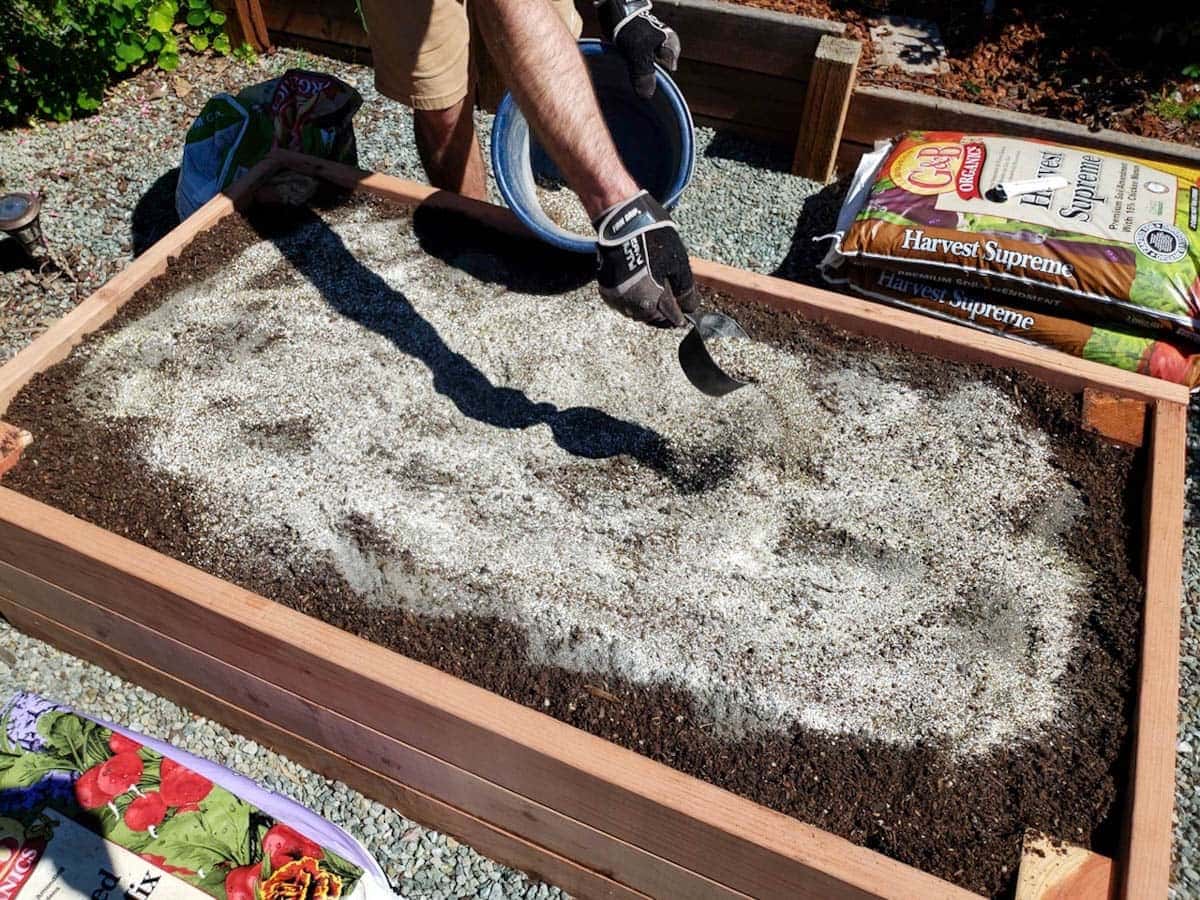
The Importance of Mulch
Last but certainly not least, don’t forget to cover the soil with a couple inches of mulch. Mulch protects and improves raised bed soil by reducing evaporation, suppressing weeds, and buffering the soil (and plant roots) from temperature swings. We typically use a woody compost as mulch. Learn more about mulching best practices and pros and cons of 8 popular mulch options here, including bark or wood chips, straw, compost, and more.
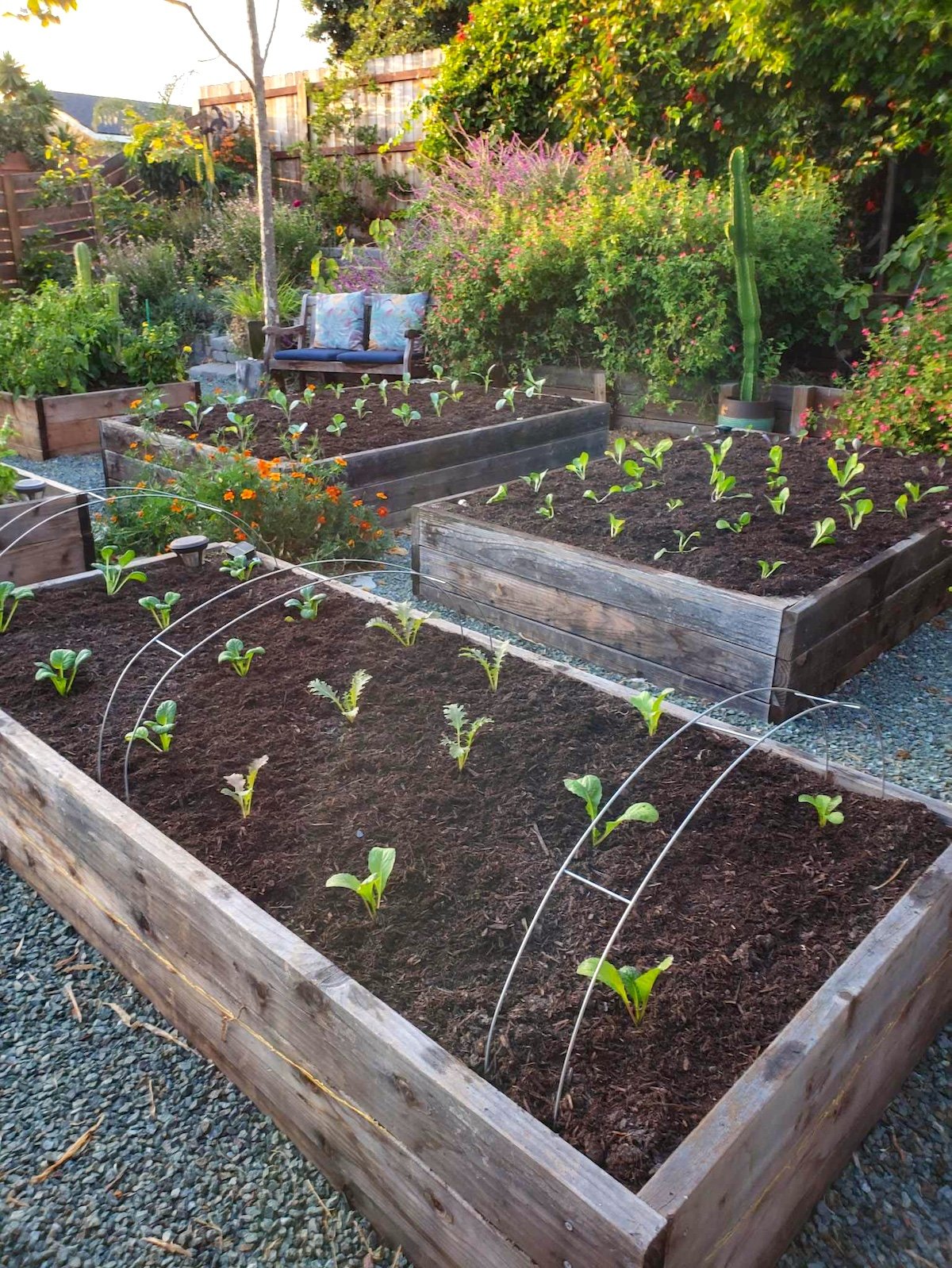
How to Improve Existing Raised Bed Soil
Do you have raised beds that are already full of soil that might not be the best quality, is having drainage issues, or the plants don’t seem to be growing very well? Don’t worry, it’s happened to us before too. But don’t feel the need to go dig out all your soil and start over. There is hope!
Before you consider replacing your raised bed soil, try amending it first using some of the materials we’ve discussed already, including compost, fertilizer, and more.
If your plants are sad and small, have you been fertilizing them adequately? Is your soil too compact? Try to loosen it up and mix in some aeration additions. Does it seem like the soil drains too quickly, or dries out too quickly? Add compost and worm castings! That, along with watering with aerated compost tea, will increase the microbial life in your soil. For better moisture retention, drainage, and “fluff”, peat moss or coco coir could also be mixed in. Note that coco coir is the more sustainable option of the two.
First, try those measures for a season and see if there is noticeable improvement. I really think there should be. If not? Next, consider taking out at least a portion of the old soil and replacing with the types of things discussed in this post.
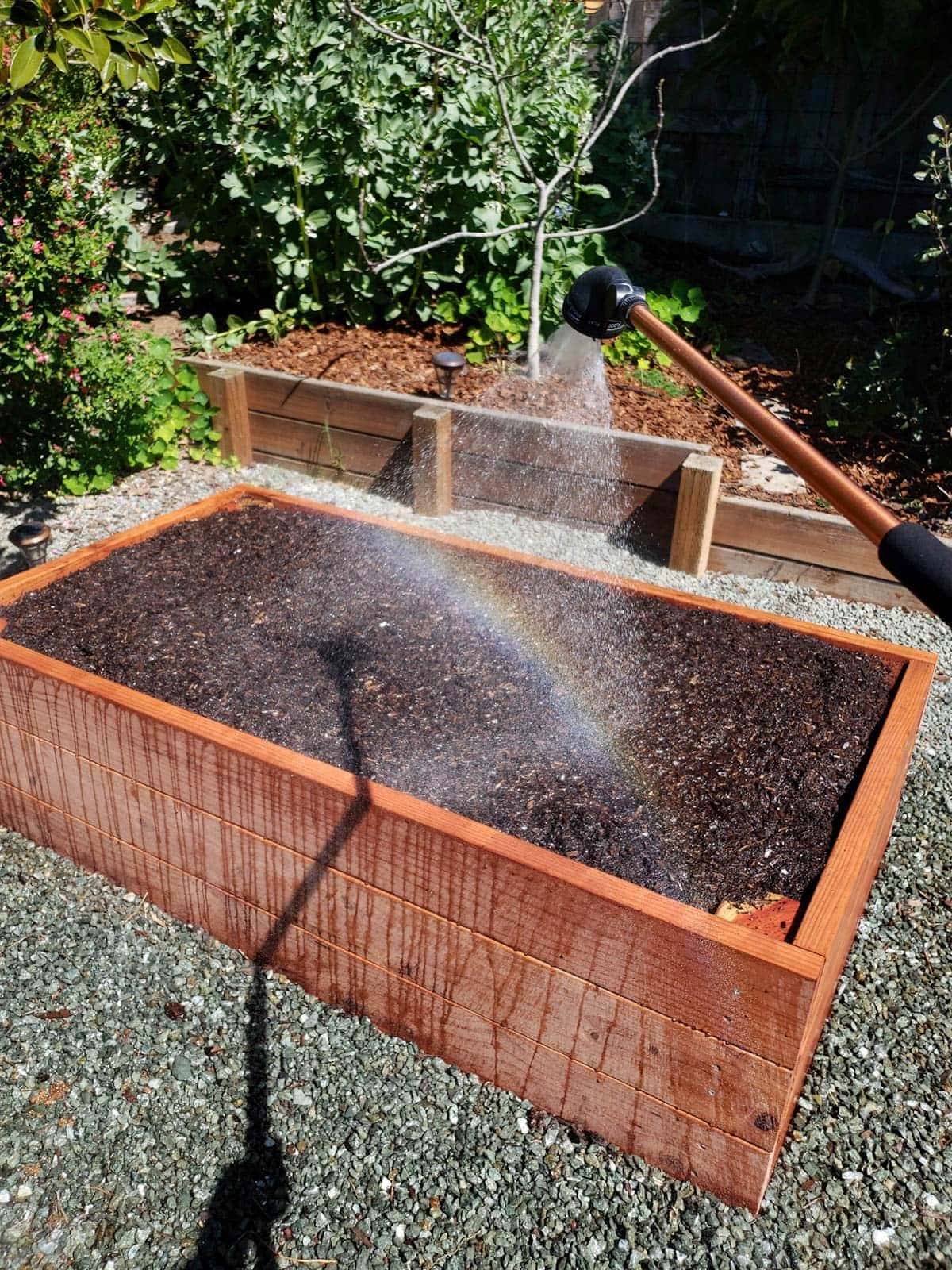
And that’s how we fill new raised garden beds with soil.
I hope that was helpful! If so, please consider leaving a review or comment below – and feel free to ask any questions! Now it’s time to put your new garden beds to good use. Don’t miss our guide on starting seeds indoors, tips for transplanting seedlings outside, or the best easy companion flowers to grow for pollinators!
You may also like:
- How to Install Drip Irrigation in Raised Beds (Drip Tape)
- 7 Ways to Make Wood Raised Beds Last Longer: Non-toxic sealer and more
- How to Make a Sturdy and Inexpensive DIY Trellis
- 9 Ways to Add Whimsy and Interest to Your Garden

How to Fill Raised Garden Beds with Organic Soil
Ingredients
- 40% soil (topsoil, loam, native soil, etc)
- 40% well-aged compost
- 20% aeration addition (e.g. sand, lava fines, perlite, pumice, coco coir, peat moss, and/or rice hulls) to improve texture, drainage, and moisture retention
- other amendments such as worm castings, rock dust, and gentle, slow-release organic fertilizers
Instructions
General Info
- Note that the soil recipe is approximate and flexible, depending on the type of base soil you use. For example, quality bagged soils usually already contain some compost and aeration additives, so you're using mostly bagged soil, you may only need about half the called-for compost and aeration.
- To fill just one or two modest raised beds, using bagged soil and compost alone may work. Yet if you're filling several raised beds, look into getting bulk soil/compost delivered from a local landscape supply company. It will be far more cost effective!

- If using mostly bagged products, do not use "potting soil" alone. Choose a mix of a few different types/brands of potting mixes, raised bed soil, and soil conditioners along with some added compost. See main post for more details and brand recommendations.

Calculating Bed Size and Soil Volume
- To calculate how much soil you need to fill a raised garden bed, begin by determining the volume of your bed in cubic feet. To do this, simply multiply the width by length by depth in feet (For example: 4’ x 8’ x 1.5′ = 48 cubic feet). Bagged soil usually comes in cubic feet.
- If you’re using bulk soil or compost too, you’ll need to calculate volume in cubic yards. To convert to cubic yards, multiply cubic feet by 0.037037 (or use this converter). Given the example of a 4×8′ by 1.5-foot deep bed used above, 48 x 0.037037 = 1.7 cubic yards of soil is needed to fill it.
How to Fill a Raised Bed
- Add the soil, compost, and aeration addition of choice in layers and mix as you go, so all of the ingredients and final soil will be as evenly mixed as possible. We also like to add worm castings mixed into the top 6 inches of the bed.

- For smaller projects, we simply used wheelbarrow and shovels. For larger projects, we used a skid steer to load into a UTV to dump into each bed.

- It's best to fill garden beds with soil all the way to the top – giving the roots as much depth to grow in as possible. When you first water a new bed it will compact and sink down a little too. Depending on how much it sinks, you may want to top it off with another layer of compost or soil.
- For extra-deep beds (over 18" tall) you can offset some of the cost by adding small logs, branches, leaves, mulch, pine needles, or other natural woody organic matter to the very bottom of the bed, and then add at least a foot of good soil and compost on top. I don't recommend this method (hugelkultur) for shallower beds.

- After filling the bed, sprinkle on some well-balanced, slow-release organic fertilizer and azomite rock dust (recommended) over the top, lightly scratch it into the soil surface, and then water the bed well.

- Don’t forget to cover the soil with a couple inches of mulch. Mulch protects and improves raised bed soil by reducing evaporation, suppressing weeds, and buffering the soil (and plant roots) from temperature swings. We typically use a woody compost as mulch, though straw and leaves are also popular options.






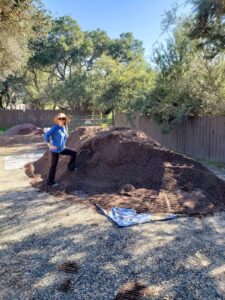
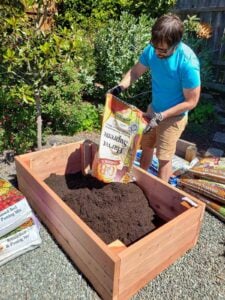
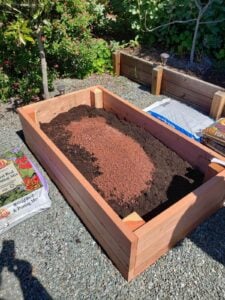
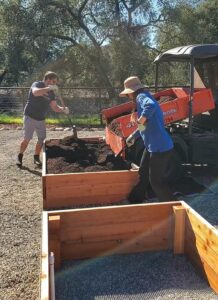
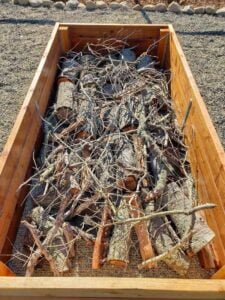
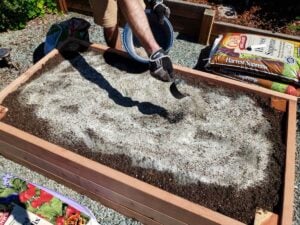





140 Comments
Jason
Hi folks!
I’ve built some 24 inch deep beds and filled them thusly: About 8 inches of wood/leaves, 10 or so inches of spent mushroom compost (we have a local business that gives it away), and finished the top with standard triple mix soil. The spent mushroom compost is horse and chicken manure, straw, and gypsum.
Do you think this is a decent starting point for a Zone 6 garden? I’m planning on planting cherry tomatoes, peppers, garlic, herbs, and one dedicated pollinator garden with native flowers.
Aaron (Mr. DeannaCat)
Hi Jason, were you going to mix the soil and compost together or are you leaving them layered like lasagna? Seems like it should work out as long as the soil isn’t too rich with compost.
Jason
It’s mostly lasagna now. I was thinking that the layers + time (August 22 – Spring 23) would let some natural biology do its work (with mulched leaves on top). Do you think I should blend it?
Aaron (Mr. DeannaCat)
It’s hard to say but we usually like to keep the compost to around 25-30% of our total soil volume, it seems like you may have a tad more than that. However, I think leaving it in layers is fine, especially so since you are topping the bed with mulched leaves. You could always throw in some winter or early spring cover crop to boost the microbes in your soil which will give everything a jump start for your summer garden. You should be good to go and have fun growing!
Day
Hi I’m wondering how many bags of Bu’s compost do you use for a 4×6 bed? I’m trying to calculate how much soil compost snd aeration I need to fill 8 beds and my numbers seem crazy huge. It’s saying I need 137 bags of compost (40%). Does that seem about accurate to what you guys have done to fill your new beds?
Aaron (Mr. DeannaCat)
Hi Day, we did a collaboration with Malibu Compost for our new garden area so we were able to get the compost in 2 yard totes. We also used a ratio of about 70% soil 25% compost and roughly 5% or less small volcanic lava cinders. When filling larger raised beds in the past, it was not economically viable to use all Malibu compost so we offset that with lower quality compost that we could get in larger amounts but we would usually add and mix in a bag or two of Malibu compost to the top portion of the raised bed. I think you can get by with a smaller percentage of compost, similar to what we used in our new space, I would also check locally to see if you have any bulk compost companies nearby or at the very least, bulk landscape supply companies that sell soil and compost by the yard. We can get a pretty good “performance blend” soil from a company around here but the compost they typically have is pretty barky and not very well broken down. In time, it will break down further into organic matter and once worms and moisture are present, it will start to become alive with microbes and other life.
So in all, if you are set on using Malibu Compost, I would look into getting one of their 2 yard totes as it should be a lot cheaper than purchasing it by the bag and use closer to 25% compost to your total soil makeup. If you have other compost available to you that may not be as good, you can still use it and mix in a couple bags of Malibu compost towards the top portion of your beds. If you are in the PNW, Oly Mountain Fish Compost may be a better option or if on the East Coast, Coast of Maine Lobster Compost. And again, you may have a really great compost producer in your area but that can vary wildly depending on where you are located. Hope that helps and good luck!
Megan
Hi Im a local. In AG. Im wondering where you buy your planters mix from? I need to buy in bulk as I’m filling 5 large raided garden beds. Thank you
Megan
Aaron (Mr. DeannaCat)
Hi Megan, we got the “performance blend” bulk soil from Central Coast Landscaping, we would recommend amending it with 20-25% with quality compost such as the bulk compost from Cal Poly or something similar. Hope that helps and good luck filling your raised beds!
cornelia
Hi; great website! Have a question: can I replace the cinder/lava rock with turface MVP in grow bags mix? what will be the ratio? I cannot find the 3/8 lava rocks here in kentucky. Thank you
Aaron (Mr. DeannaCat)
Hi Cornelia, you can use perlite if you would like as an alternative but you don’t need to add any extra of either as long as your main soil mix has decent aeration. We can get soil by the yard from a local landscape supply company that is called “performance blend”, we use about 70% of that mix with close to 30% compost and it works out great. Hope that helps and good luck!
Lisa
Hi guys my husband and I are new to growing. We live in Arizona and we received 3 days of nonstop Monsoon rain a few weeks ago. Since then our 3 tall photos which recently began flowering have started yellowing on the bottom part of the plant. I am also seeing what may be the start of a magnesium deficiency. We followed your ROLS recipe and we also grow in 25 gallon fabric grow bags. This week they got a dose of neem/kelp ( top dress). Can you suggest anything that i can try for the magnesium? I have been reading that if left unattended it could spiral quickly. Thank you.
Aaron (Mr. DeannaCat)
Hi Lisa, kelp meal is a great amendment and one that we will use throughout the growing season as a top dress or as a tea. Have you been regularly feeding your plants via top dressing or teas throughout their growth so far? It is great that you just gave your girls a top dress, however, that is something that will be broken down slowly so a tea may have quicker effects. I would make a kelp tea to water your plants with and that should be absorbed more quickly than your top dress. Do you have access to high quality worm castings or compost? If so, another option would be to make a compost tea and water your plants thoroughly with that. If either option is viable, I would use compost tea first and then make kelp tea for later in the week. As in, if you are watering 3 times a week, give the compost tea on Monday and the kelp tea on Friday. I am also not sure how worried I would be about the yellowing leaves as that usually happens from the bottom of the plant first as it ages. As the plant continues to flower, it will put more energy into its flowers at the expense of its leaves, although all strains are different and some stay green longer while others will start to fade sooner. Hope that helps and good luck!
Cathy
We are building elevated gardening beds since we are on a slope. What material should we line our beds with to keep the wood from rotting. I’m particularly concerned about anything leeching into the vegetables. What would your suggestions be
Aaron (Mr. DeannaCat)
Hi Cathy, we don’t line our beds with anything aside from commercial grade landscape fabric. Your beds should still last close to 10 years if you use redwood or cedar so I wouldn’t worry about them rotting. Hope that helps and good luck!
Eduardo
Hello AARON, thank you for the excellent material you share on your website. I just constructed my raised beds with treated pine wood but now I’m in search of good material to protect the soil from those wood chemicals. Thank you for your time.
Alyssa
Hi! I’m wondering about what ratios of mellow meals you use. I bought Down-To-Earth crab meal, alfalfa meal, and kelp meal. I’m planning to add a mixture of all three to my beds. When mixing these meals, do you use the amounts per cu/ft recommended on the box for each one? Or do you use less of each since you are combining them? I don’t want to burn my plants by going overboard. Thanks for all the information you provide!
Aaron (Mr. DeannaCat)
Hi Alyssa, we usually determine the amount by the square footage of the raised bed and we usually apply less than what it says on the package. I think on an 8×4 (32 square feet) foot bed when amending between seasons I would add about 1.5-2 cups kelp meal, 2-3 cups crab meal, and 2 cups alfalfa meal. The alfalfa is the one amendment that is “hot” and can burn your plants so it is best to go easy on that one compared to the others. During the growing season we usually add equal amounts of each amendment and top dress tomato plants with 1/4 to 1/2 cup of the mixed amendment and an 1/8th cup mixed amendments for peppers, eggplant, and squash each month. Hope that is enough to get you started and happy gardening!
mike barnett
We built some elevated beds, so they do not sit on the ground. I am assuming the 40% soil, 40% compost, 20% aeration applies, but when you look at a product like Kellogg Raised Bed and Garden Mix, where does that fit in the ratio?
Aaron (Mr. DeannaCat)
Hi Mike, I would consider that soil mix a combo of soil and compost although it does have some bits of perlite as well. If Kellogg is your main option, I would also add some of their Patio Plus as well as their Amend lines to add a bit more richness to your mix. Gardner and Bloome is Kellogg’s organic option and one that I would try and locate if it’s available in your area. We will usually use a combination of G&B’s Raised Bed Mix, Potting Mix, Planting Mix, Harvest Supreme, and/or Soil Conditioner as mulch. Hope that helps and good luck!
Riley
Is coco coir a good choice for aeration in raised beds?
Aaron (Mr. DeannaCat)
Hi Riley, yes it will help make your soil more light and fluffy which will create more pockets for air, it will also help retain moisture as well. If you are mixing it into a combination of potting soil and compost, maybe add 10-20% of the total volume of soil needed. Hope that helps and good luck!
Barb
OMG, thank you so much for all your incredible, easy to understand and useful information. I am so glad I came across your website. Working on my garden beds now, hoping to get my act together to make GF sourdough bread!
Aaron (Mr. DeannaCat)
Good luck on those garden beds Barb and baking sourdough is a lot of fun so hopefully you get to it before too long!
Paul Sapienza
I need to fill raised beds that are 32 inches deep (2 feet 8 inches) 8 feet long and 4 feet wide
Should I use the entire depth with the 40-40-20% ratio or should I fill the bottom with dirt from my backyard to a certain depth and then add the ratio mix
Aaron (Mr. DeannaCat)
Hello Paul, those are some deep beds! We usually fill the bottom of extra deep beds with soil that we can get in bulk that is usually not as great to grow directly in but with time it will become just as rich as the rest of the bed. So adding soil from your yard is fine as long as there aren’t too many pests, disease, or anything else to worry about. Another option if you have fallen trees or logs on your property is to fill the bottom with branches, logs, leaves, etc. as it will take up space and will break down with time turning into organic matter. Hope that helps and good luck!
Lynn Baden
Hi. Love your website. I am gardening vegetables for the first time this year and bought the metal raised beds. I have purchased my soil and before I fill the beds, I have a question. Do you put any type of product on the ground prior to filling the bed? I was thinking specifically about garden cloth. Any thoughts?
Thanks
Lynn
Aaron (Mr. DeannaCat)
Hello Lynn, congrats on getting into gardening for the first time. It really turns into a healthy hobby and lifestyle. As far as your question is concerned, it really depends on what is growing in the ground where you are going placed the raised beds. If you just have basic grass and there are no pesky weeds that may work their way into your beds, using a few layers of cardboard on the bottom of the beds will help suppress grass and any mild weed activity. If you have weeds that like to travel and invade most things, cutting out an area for your beds and placing contractor weed fabric over the top and affixing it with landscape staples would be recommended. You can then either lay mulch or gravel around the surrounding beds to help tie everything together. Check out our How to Kill or Remove Grass (& Grow Food Not Lawns!) article for more ideas. Hope that helps and good luck to you. Let us know if you have any other questions.
Jeni
Hi there! Brand new to gardening. We just built raised beds for vegetables and flowers and had a bulk order of “garden blend soil” dropped off. It is quite smelly of cow manure and I’m worried it is too fresh/not aged and perhaps too high a percentage of compost to sand and soil. Any suggestions on how to work with it? I was thinking of trying to blend it with the existing dirt underneath to tone it down a bit. In Vancouver BC where the earth we’re digging into seems quite rich as is (we dug up grass before putting down our cedar beds). Thanks for your help!
Aaron (Mr. DeannaCat)
Hello Jeni, congrats on getting into gardening, living in Vancouver BC that is a great idea as it is quite a green and beautiful place! It is really hard to tell how “hot” the soil is or not without knowing the product firsthand. You could double check with the company who sells the product and inquire about the exact ingredients and if the manure has been composted long enough. Although your idea of mixing it partway with your native soil sounds like an excellent idea as the native soil is most likely very rich and alive. For what it’s worth, a lot of garden soil, especially bagged soil can have a bit of a smell to it with no negative effect on plants. Good luck and happy gardening!